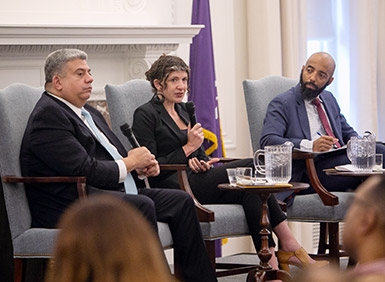Kenneth Thompson Lecture examines alternatives to incarceration
On March 9, the impact of Kenneth Thompson ’92’s tenure as Brooklyn’s first black district attorney was examined in the annual lecture named for him. The panel of speakers also explored alternative retribution procedures that are aimed at curtailing mass incarceration in Brooklyn and throughout the United States.
The Kenneth P. Thompson ’92 Lecture on Race and Criminal Justice Reform began in 2019 as part of the Ken Thompson Social Justice Fund, established at NYU Law through a gift by Lu-Shawn Thompson in memory of her husband, who passed away in 2016. The event was co-hosted by the Center on Race, Inequality, and the Law (CRIL) and the Center on the Administration of Criminal Law, and was moderated by CRIL executive director Vincent Southerland.
This year’s lecture took the form of a discussion between experts in the criminal justice system who had worked closely with Thompson: Danielle Sered, founder and executive director of Common Justice, a national nonprofit that partners with district attorneys’ offices to provide incarceration-alternative programming; and Eric Gonzalez, district attorney for Kings County, Brooklyn, who served as assistant district attorney under Thompson.
“When I think of the legacy of [Thompson’s] office, I think of his decision to decline the prosecution of marijuana arrests,” Sered said, noting that such arrests disproportionately impact communities of color. According to Sered, this often put Thompson at odds with his colleagues in the police force. “The boldness and the courage and the clarity of his willingness to do that and to be grounded in what he understood as a commitment to securing justice, not just to secure conviction, is really profound and is lasting in the shape of New York City,” Sered said.
Currently, Sered and Gonzalez are working together to continue another priority of Thompson’s office: alternatives to incarceration. Sered’s nonprofit, Common Justice, provides alternative programming for serious and violent felonies, “if and only if the DA’s office and the survivor agree,” Sered said. If that criterion is met, the perpetrator goes through a violence intervention curriculum which includes acknowledging the harm they’ve caused to the victim or victim’s family, and working with the survivor to create a plan for retribution, which can include elements such as community service and counseling. “And if, over the next years, they continue the program, they fulfill those agreements, and they graduate from the program, then the felonies or charges against them are dismissed and they’re left with a conditional discharge and misdemeanor,” Sered said.
Gonzalez acknowledged that acceptance of this alternative program, which Sered called “restorative justice,” has been slow in DA’s offices. “Many career prosecutors who came through the 80s and 90s were in a culture where you had to be tough on crime,” Gonzalez said. “DAs across the country were comparing the effectiveness of their office by how many trials, how many convictions, and the length of sentences—which sometimes became shorthand for how seriously a case was treated.”
Despite this resistance, Gonzalez said that restorative justice makes communities safer. Often, he said, victims of a crime experience renewed fear if a perpetrator is released into the community after serving a sentence without acknowledging harm done. But, Gonzalez said, Common Justice helps create a change in mindset. “The recidivism among the cohort of people who participate in [Common Justice] is extremely low,” he added.
According to Sered, 90 percent of victims, when presented with the opportunity to allow a perpetrator to go through Common Justice, opt for Common Justice over incarceration.
“It’s not because they want to be on the cutting edge of criminal justice reform, and it’s not usually because they’re merciful or forgiving,” said Sered. “It’s because they want to choose something that is in their own interest, the interest of their children, the interest of the other children on their block. They cannot be persuaded, after the failure of this decades-long experiment—mass incarceration—that incarceration does anything to improve their community,” she said.
Posted May 1, 2020


